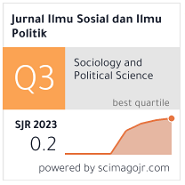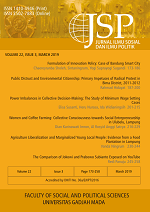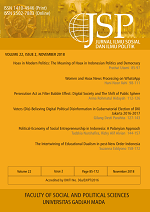Voters (Dis)-Believing Digital Political Disinformation in Gubernatorial Election of DKI Jakarta 2016-2017
Gilang Desti Parahita(1*)
(1) Department of Communication Studies, Faculty of Social and Political Sciences, Universitas Gadjah Mada
(*) Corresponding Author
Abstract
Some studies, with regards to the salience of digital disinformation, have focused on investigating the tendency to believe disinformation by looking at a single cluster of factors. This study reveals factors ranging from multiple clusters, such as socioeconomic status, political partisanship, diversity of media exposure, trust in the media, and the digital fluency of the voters. The Gubernatorial Election of DKI Jakarta during 2016-2017 provided a context for examining the correlation between these factors and the (dis)-belief of digital political disinformation among the voters. In the election, the incumbent governor, Basuki Tjahja Purnama, was falsely accused of being a communist, which is still a dirty word in Indonesia, by his opponent. A survey was conducted for this research, collecting completed questionnaires from 191 citizens of DKI Jakarta who had voting rights and could access the online and digital disinformation. The null hypothesis was that socioeconomic status, political partisanship, diversity of media exposure, trust in the media and digital fluency did not influence the citizens’ perceptions towards digital political information. However, the regression analysis found that the null hypothesis should be rejected. Of those predictors, political partisanship had the highest significant correlation with those perceptions.
Keywords
Full Text:
PDFReferences
Accenture & Femina. (2016). Getting to Equal: How digital is helping close the gender gap at work. Digital Fluency Indonesia Report, retrieved from https://www.accenture. com/ t20160506T060137__w__/id-en/_ acnmedia/Accenture/ConversionAssets/ DotCom/Documents/ About-Accenture/ PDF/3/AccentureIWD-2016-Digital- Fluency-IndonesiaReport.pdf.
Arpan, L. M. & Rane y, A. A. (2003). An experimental investigation of news source and the hostile media effect. J&MC Quarterly, 80(2), 265-281. doi:10.1177/107769900308000203.
Austin, E. W., & Dong, Q. (1994). Source v. content effects on judgments of news believability. Journalism & Mass Communication Quarterly, 71(4), 973-983.
Bologa, R., Lupu, A. R., & Saba, G. (2007). Digital fluency and its importance in educating young students for the knowledge age. In Congyan, L. (Eds.). Proceedings of the 7th WSEAS International Conference on Distance Learning and Web Engineering (pp. 354-357). Beijing, China: World Scientific and Engineering Academy and Society (WSEAS).
BPS DKI Jakarta. (2015). SUPAS 2015: Profil Kependudukan Hasil SUPAS 2015. Jakarta: BPS DKI Jakarta.
Burgess, S., Sellitto, C., Cox, C. & Buultjen, J. (2011). Trust perceptions of online travel information by different content creators: some social and legal implications. Information System Frontiers, 13(2), 221-235.
Edelman Trust Barometer. (2017). 2017 Edelman Trust Barometer: Global and I nd o ne s sia. R etr ie ve d fr o m https : // e d e l m a n . i d /tr u s t2 0 1 7 /w p - c o n te n t/ uploads/2017/02/2017-Trust-Barometer_ Indonesia_FINAL-VERSION-Share.pdf.
Enns, P. K., & McAvoy, G. E. (2012). The role of partisanship in aggregate opinion. Political Behaviour, 34(4), 627-651. doi:10.1007/s11109-011-9176-7.
Feldman, L. (2011). Partisan differences in opinionated news perceptions: a test of the hostile media effect. Political Behavior, 33(3), 407-432.
Fico , F., Ric hard s on, J. D., & Ed ward s , S. M. (2004). Influence of story structure on perceived story bias and news organization credibility. Mass Communication and Society, 7(3), 301-318.
Fitzgerald, M. A. (1997). Misinformation on the internet: applying evaluation skills to online information. Emergency Librarian, 24(3), 9-14.
Flanagin, A. & Metzger, M. J. (2000). Perceptions of Internet and Information Credibility, J&MC Quarterly, 77(3), 515-540.
Gaziano, C. & McGrath, K. (1985). Media Publics and Media Trust. Retrieved from https:// files.eric.ed.gov/fulltext/ED263610.pdf.
Hamid, A. (2014). Jokowi’s populism in the 2012 Jakarta Gubernatorial Election. Journal of Current Southeast Asian Affairs, 33(1), 85-109.
Hendrie, A.G.m Coveney, J., Cox, D. (2008). Exploring nutrition knowledge and the demographic variation in knowledge levels in an Australian community sample. Public Health Nutrition, 11(12), 1365–1371 doi:10.1017/S1368980008003042.
Houston, B., Hansen, G. J., & Nisbett, G. S. (2011). Influence of user comments on perceptions of media bias and third- person effect in online news. Electronic News, 5(2), 79-92.
Hutabarat, D. (2018). Berita hoax akan diumumkan di laman Kominfo, kenali ciri-cirinya. Retrieved from https://kominfo.go.id/content/detail/14708/berita-hoax-akan- diumumkan-di-laman-kominfo-kenali- ciri-cirinya/0/sorotan_media.
Hutchinson, W. (2006). Information warfare and deception. Informing Science Institute, 9,213-223.
Jang, S. M. (2013). Seeking congruency or incongruency or in online? examining selective exposure to four controversial science issues. Science Communication, 36(2), 143-167.
Johnson, T. J., & Kaye, B. K. (2009). In blog we trust? deciphering credibility of components of the internet among politically interested internet users. Computers in Human Behavior, 25(1), 175-182.
Kato, H. (2017). The challenge to religious tolerance: fundamentalits’ resistance to a non-muslim leader in Indonesia. Comparative Civilizations Review, 77(77), 77-89.
Kiousis, S. (2001). Public trust or mistrust? perceptions of media credibility in the information age. Mass Communication and Society, 4(4), 381-403.
Kohring, M. & Matthes, J. (2007). Trust in media development and validation of a multidimensional scale. Communication Research, 34(2), 231-252.
Kwok, Y. (2017, January 6). Where memes could kill: Indonesia’s worsening problem of fake news. Time.com. Retrieved from http://time.com/4620419/indonesia-fake- news-ahok-chinese-christian-islam/.
Ladd, J. M. (2010). The role of media distrust in partisan voting. Political Behavior, 32(4), 567-583.
Lee, T. T. (2005). The liberal media myth revisited: an examination of factors influencing perceptions of media bias. Journal of Broadcasting & Electronic Media, 49(1), 43-64.
Lee, T.T. (2010). Why they don’t trust the media: an examination of factors predicting trust. American Behavioral Scientist, 54(1), 8-21.
Lindsey, T. (2018). Rise of conservative Islam in Indonesia. Australian Institute of International Affairs. Retrieved from https://www.internationalaffairs.org.au/ australianoutlook/jokowis-deputy-pick- confirms-rise-of-conservative-islam-in- indonesia/.
Mahtani, M. (2008). Racializing the audience: Immigrant perceptions of mainstreamCanadian English Language TV News.Canadian Journal of Communication, 33(4). doi:10.22230/cjc.2008v33n4a2030
Metzger M. J., Flanagin, A. J., Eyal, K., Lemus, D.R., & Mccann, R. M. (2003). Credibility for the 21st century: integrating perspectives on source, message and media credibility in the contemporary media environment. In P. J. Kalbfleisch (Eds.), Communication Yearbook 27 (pp. 293-335). Mahwah, New Jersey, US: Lawrence Erlbaum Associates, Inc., Publishers.
Miller, C. & Bartlett, J. (2012). ‘Digital Fluency’: towards young people’s critical use of the internet. Journal of Information Literacy, 6(2), 35-55.
Miichi, K. (2014). The role of religion and ethnicity in Jakarta’s 2012 gubernatorial election. Journal of Current Southeast Asian Affairs, 33(1), 55– 83.
Nichols , C., McKinnon, L., & Geary , A. (2016). Rumor has it: examining the effects of facebook addiction on political knowledge gullibility. The Journal of Social Media in Society, 5(1), 229-264.
Novitasari, S. C. (2017, April 21). Isu SARA, cara ampuh menggerus Ahok-Djarot. CNN. Retrieved from http://ww w. cnnindonesia.com/kursipanasdki1/20170421112806-521-209209/isu-sara- cara-ampuh-menggerus-ahok-djarot/
Nugroho, I. (2017, April 21). Sentimen agama dan blunder Ahok. Detik.com. Retrieved from https ://x.detik.com /detail/ investigasi/20170421/Sentimen-Agama- dan-Blunder-Ahok/index.php
Nugroho, Y., Nugraha, LK., Laksmi, S., Amalia, M ., Putri, DA ., A m alia, D., (2012). Media and the vulnerable in Indonesia: Accounts from the margins. Report Series. Engaging Media, Empowering Society: Assessing media policy and governance in Indonesia through the lens of citizens’ rights. Research collaboration of Centre for Innovation Policy and Gov ernance and HIVOS Regional Office Southeast Asia, funded by Ford Foundation. Jakarta: CIPG and HIVOS.
Qazvinian, V., Rosengren, E., Dragomir, R., & Qiaozhu, R. (2011). Rumor has it: identifying misinformation in microblogs. Proceedings of the 2011 Conference on Empirical Methods in Natural Language Processing (pp. 1589-1599). Edinburg, Scotland, UK: Association for Computational Linguistics.
Renard, J. B. (2007). Denying rumours. Diogenes, 54(1), 43-58.
Ritzhaupt, A. D., Liu, F., Dawson, K., & Barron, A. E. (2013). Differences in student information and communication technology literacy based on socioeconomic status, ethnicity, and gender. Journal of Research on Technology in Education, 45(4), 291-307. doi:10.1080/15391523.2013.10782607
Schmitt, K. M., Gunther, A. C., & Liebhart, J.L. (2004). Why partisan see mass media as biased. Communication Research, 31(6), 623-641.
Setijadi, C. (2017). T he Jakarta E lection Continues: What Next for Embattled Governor Ahok? Perspective. Retrieved from https://iseas.edu.sg/images/pdf/ ISEAS_Perspective_2017_18.pdf.
Shatz, M., Diesendruck, G., Martinez-Beck, I., & Akar, D. (2003). The influence of language and socioeconomic status on childrens understanding of false belief. Developmental Psychology, 39(4), 717-729. doi:10.1037/0012-1649.39.4.717
Sheth, D. L. (1971). Partisanship and political development. Economic and Political Weekly, 6(3/5), 259-261+263+265+267+269+271+273-274.
Shin, J., Jian, L., Driscoll, K. & Bar, F. (2016). Political rumoring on twitter during the 2012 us presidential election: rumor diffusion and correction. New Media and Society, 19(8), 1214-1235.
Suaedy, A. (2014). The role of volunteers and political participation in the 2012 Jakarta gubernatorial election. Journal of Current Southeast Asian Affairs, 33(1), 111–138.
Thorson, E. (2016). Belief Echoes: the persistent effects of corrected misinformation. Political Communication, 3(3), 460-480.
Tran, H. (2013). Does Exposure to online media matter? the knowledge gap and the mediating role of news use. International Journal of Communication, 7(1), 831-852.
Tsfati, Y. & Cappella, J.N. (2005). Why do people watch news they do not trust? the need for cognition as a moderator in the association betw een news media scepticism and exposure. Media Psychology, 7(3), 251-271.
Tsfati, Y. (2010). Online news exposure and trust in the mainstream media: exploring possible associations. American Behavioral Scientist, 54(1), 22 –42.
Vltchek, A. (2017). 52 Years after fascist genocide, Indonesians scared of “Communist Ghosts”: from Jakarta and Yogyakarta. Global Research. Retrieved from https:// www.globalresearch.ca/52-years-after- fascist-genocide-indonesians-scared-of- communist-ghosts/5612709.
Vreese, C. de. & Neijens, P. (2016). Measuring m ed ia expo s ure in a c hanging communications environment. Communication Methods and Measures, 10(2-3), 69-80.
Wang, E., Myers, M. D., & Sundaram, D. (2012). Digital natives and digital immigrants: towards a model of digital fluency. E uro p ea n C o nf erenc e o n I nf o rm a t i o n Systems (ECIS) 2012 Proceedings. Spain: Association for Information Systems AIS Electronic Library (AISeL).
Watts, M. D., Domke, D., Shah, D. V., & Fan, D.P. (1999). Elite cues and media bias in presidential campaigns: Explaining public perceptions of a liberal press. Communication Research, 26(2), 144-175. doi: 10.1177/009365099026002003
White, J. & Ypi, Lea. (2011). On partisan political justification. The American Political Science Review, 105(2), 381-396. doi: 10.1017/ S0003055411000074
White, G.K. (2013). Digital fluency: skills necessary for learning in the digital age. Retrieved from https://research.acer.edu. au/digital_learning/6/.
William s , A . E . (2012). Trus t o r bus t? : Questioning the relationship between media trust and news attention. Journal of Broadcasting & Electronic Media, 56(1),116- 131. Doi: 10.1080/08838151.2011.651186.
Williams, D.R., Yu, Y., Jackson, J.S., & Anderson, N.B. (2017). Racial differences in physcial and mental helath: Socio-economic status, stress, and discrimination. Journal of Health Psychology, 2(3), 335–351.
Yang, K. C. C. (2007). Factors influencing internet users’ perceived credibility of news-related blogs in Taiwan. Telematics & Informatics, 24, 69-85. doi: 10.1016/j. tele.2006.04.001.
Yee, A. (2017). Post-truth politics and fake news in Asia. Global Asia, 12(2), Summer 2017.
Article Metrics
Refbacks
- There are currently no refbacks.
Copyright (c) 2019 Jurnal Ilmu Sosial dan Ilmu Politik

This work is licensed under a Creative Commons Attribution-NonCommercial-NoDerivatives 4.0 International License.






















